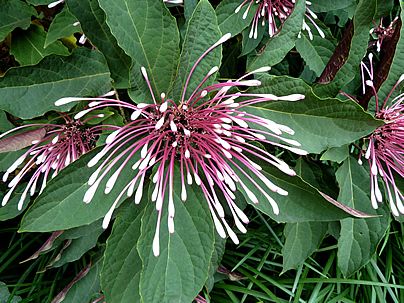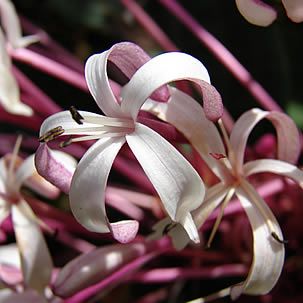The Starburst (Clerodendrum quadriloculare) is a shrubby, semi-woody plant, known for its ornamental foliage and flowering, native to the Philippines and New Guinea. It features a branched stem from the base, erect and capable of reaching up to 20 feet (about 6 meters) in height, although it usually does not exceed 10 feet (about 3 meters). It can be evergreen to semi-deciduous, depending on the climatic conditions of where it is grown.
Its leaves are large, opposite, lanceolate, elliptical to oblong, pubescent, with well-marked veins and irregularly toothed margins. A notable feature of the leaves is the dark green to slightly bluish upper side and the purplish underside, which makes the plant attractive even when not in bloom. There is also a cultivar with variegated cream-yellow leaves.

It blooms in spring, presenting terminal inflorescences of the panicle type, dense, with numerous tubular, long flowers, similar to cotton swabs when still closed, and which open into five recurved petals, revealing the stamens. The flower’s calyx is red and the corolla can be pink or white. The ensuing fruits are ellipsoidal, purplish drupes with four locules, which gave it the botanical name ‘quadriloculare‘.
A spectacular plant and still underutilized in landscaping, the Starburst can be grown alone, as a focal point, or in groups and rows. As a hedge, it provides privacy to the property. The dark foliage can offer an excellent backdrop for other smaller species with lighter green colors. Furthermore, its exuberant flowering attracts many graceful visitors, such as hummingbirds and butterflies. Through pruning, it’s possible to maintain and stimulate its shrubby behavior and densification, and it can also be trained to become a graceful small tree.

As a small tree, it is interesting for use in sidewalks and walkways. It’s also ideal for planting in large pots, decorating patios, balconies, terraces, or even as a gift. Hardy, it does not require extensive maintenance, which usually involves removing new shoots that arise from the roots and annual pruning, carried out after the end of flowering.
It should be grown in full sun or partial shade, in fertile, drainable soil, enriched with organic matter, and watered regularly in the first year of implementation. After full establishment, the Starburst becomes tolerant to short periods of drought, as well as excessively rainy periods prone to waterlogging.
The Starburst thrives in tropical heat and humidity. Under frosts or intense cold, it suffers, losing all its leaves and possible buds, but it usually sprouts again in the spring. Fertilize monthly in spring and summer, with fertilizers suitable for flowering. It multiplies by seeds, but more commonly by separating the shoots that spontaneously emerge around the mother plant.


